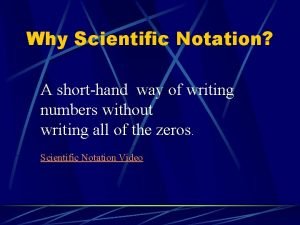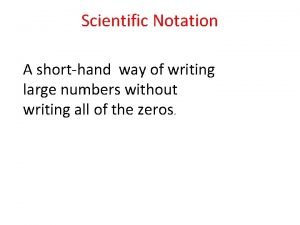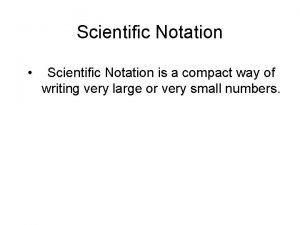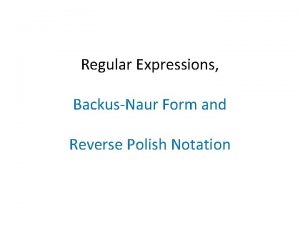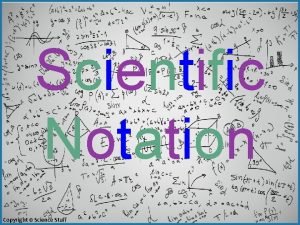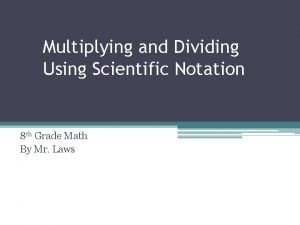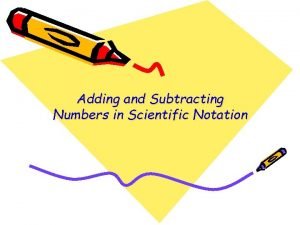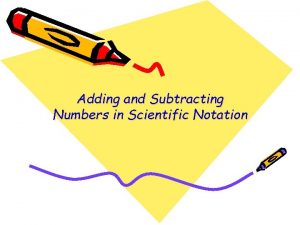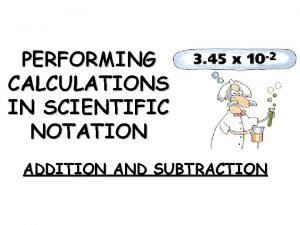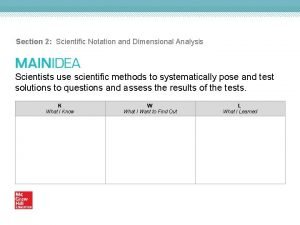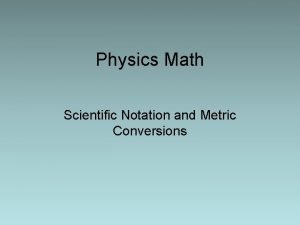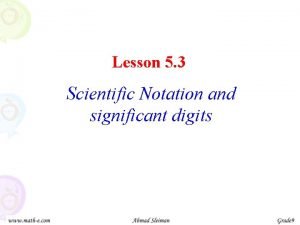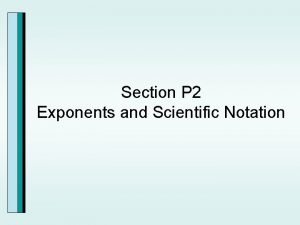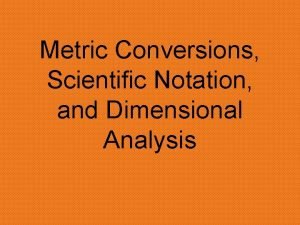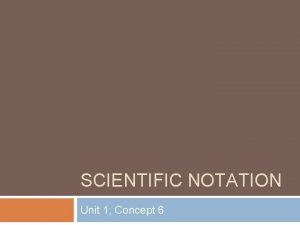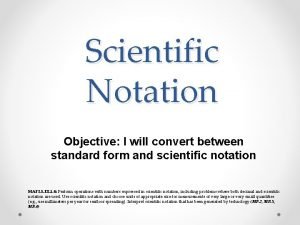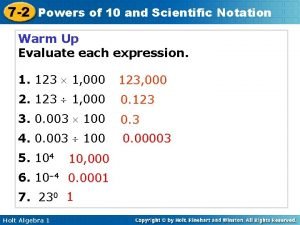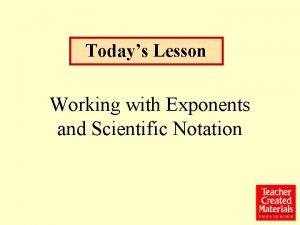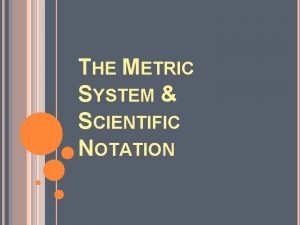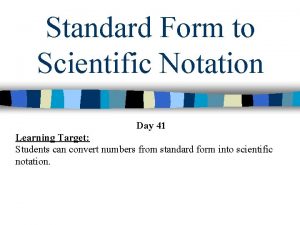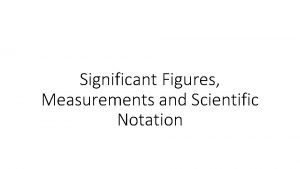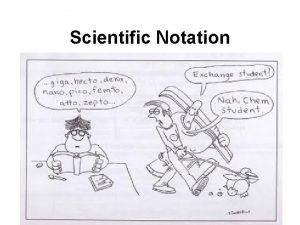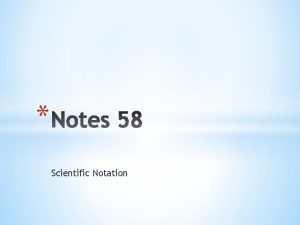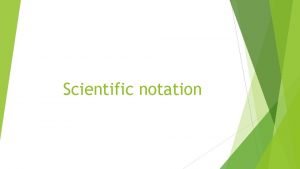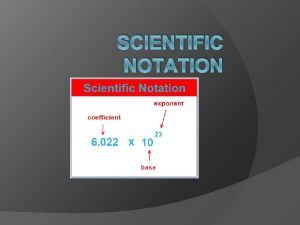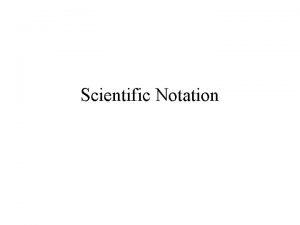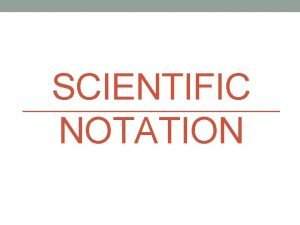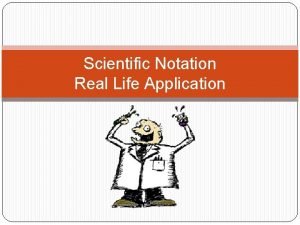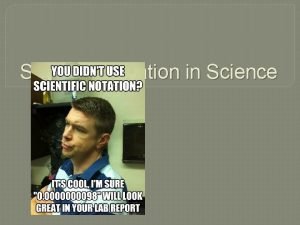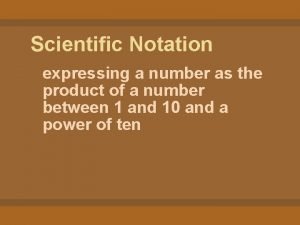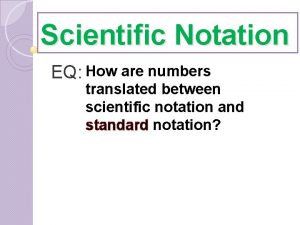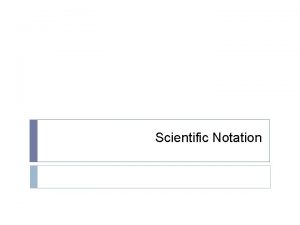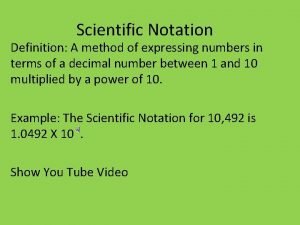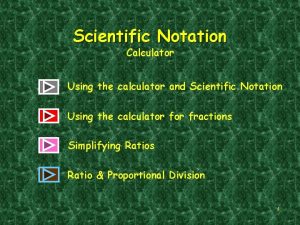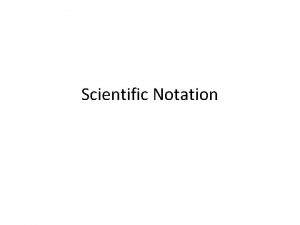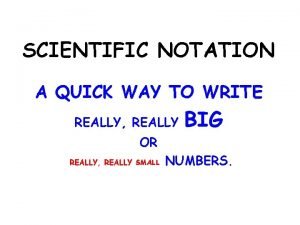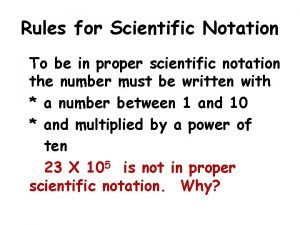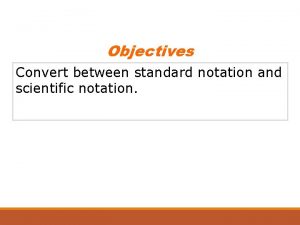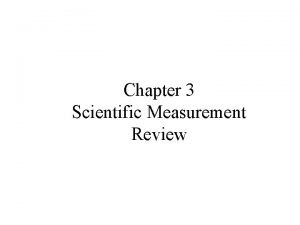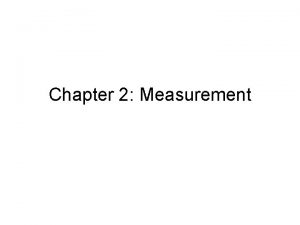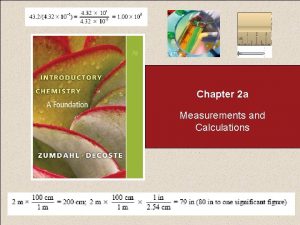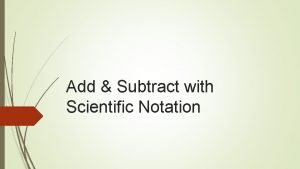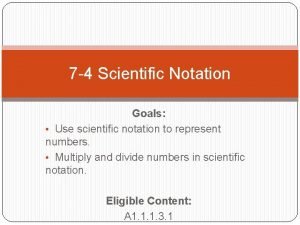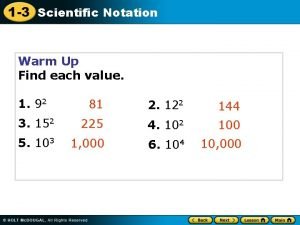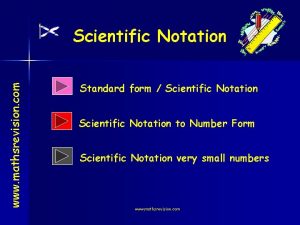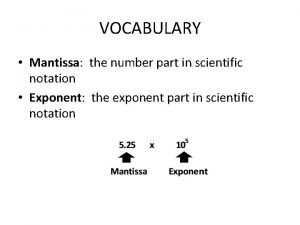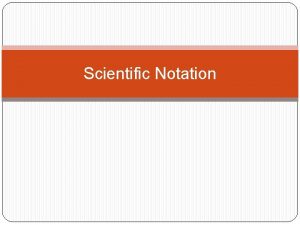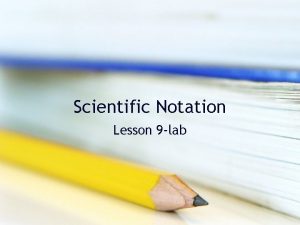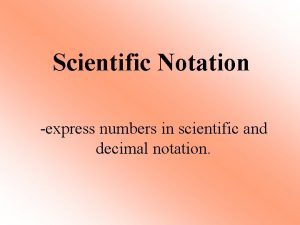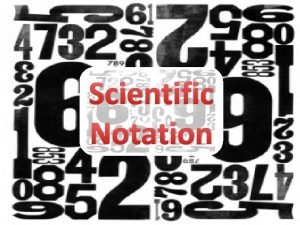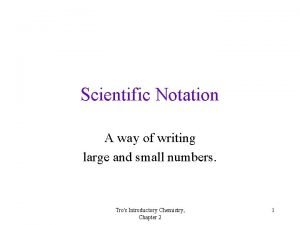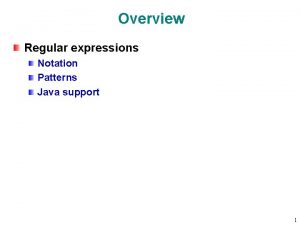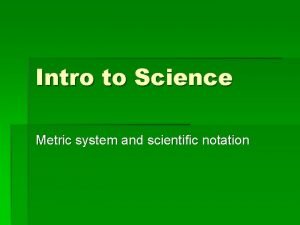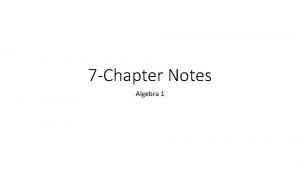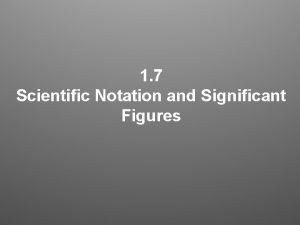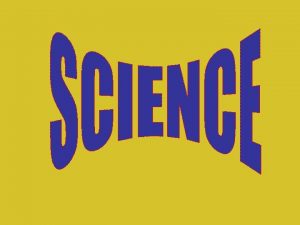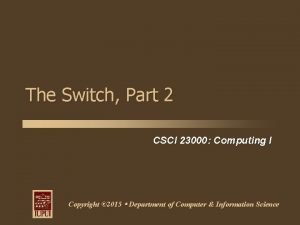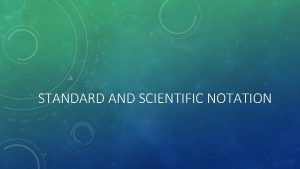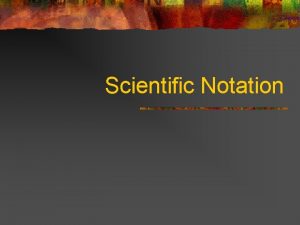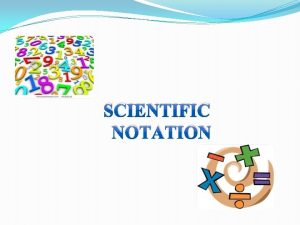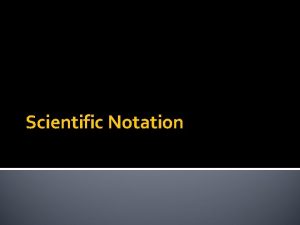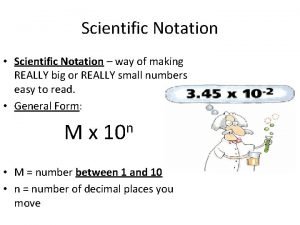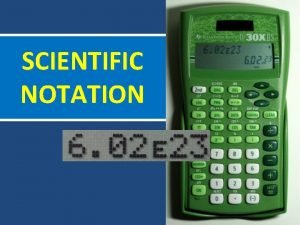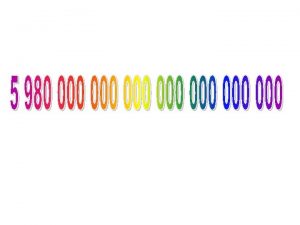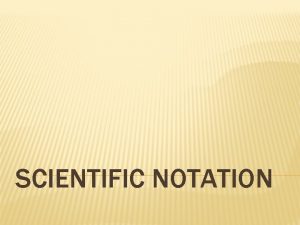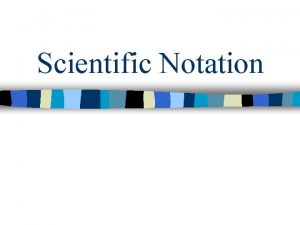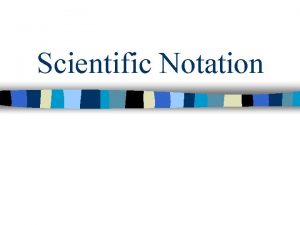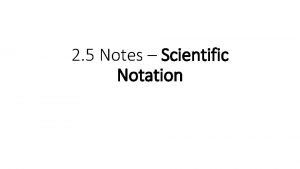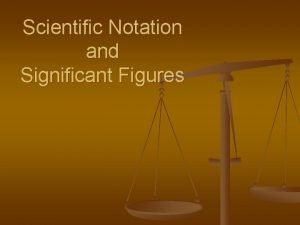Scientific Notation A way of writing large and












































































- Slides: 76

Scientific Notation A way of writing large and small numbers. Tro's Introductory Chemistry, Chapter 2 1

Big and Small Numbers • We commonly measure objects that are many times larger or smaller than our standard of comparison. • Writing large numbers of zeros is tricky and confusing. üNot to mention there’s the 8 digit limit of your calculator! Tro's "Introductory Chemistry", Chapter 2 The sun’s diameter is 1, 392, 000 m. An atom’s average diameter is 0. 000 000 3 m. 2

Scientific Notation • Each decimal place in our number system represents a different power of 10. • Scientific notation writes the numbers so they are easily comparable by looking at the power of 10. Tro's "Introductory Chemistry", Chapter 2 The sun’s diameter is 1. 392 x 109 m. An atom’s average diameter is 3 x 10 -10 m. 3

Exponents • When the exponent on 10 is positive, it means the number is that many powers of 10 larger. üSun’s diameter = 1. 392 x 109 m = 1, 392, 000 m. • When the exponent on 10 is negative, it means the number is that many powers of 10 smaller. üAverage atom’s diameter = 3 x 10 -10 m = 0. 000003 m. Tro's "Introductory Chemistry", Chapter 2 4

Scientific Notation • To compare numbers written in scientific notation: üFirst compare exponents on 10. üIf exponents are equal, then compare decimal numbers Exponent 1. 23 x Decimal part 10 -8 1. 23 x 105 > 4. 56 x 102 4. 56 x 10 -2 > 7. 89 x 10 -5 7. 89 x 1010 > 1. 23 x 1010 Exponent part Tro's "Introductory Chemistry", Chapter 2 5

Writing Numbers in Scientific Notation 1. Locate the decimal point. 2. Move the decimal point to obtain a number between 1 and 10. 3. Multiply the new number by 10 n. ü Where n is the number of places you moved the decimal point. 4. If you moved the decimal point to the left, then n is +; if you moved it to the right, then n is −. ü If the original number is 1 or larger, then n is +. ü If the original number is less than 1, then n is −. Tro's "Introductory Chemistry", Chapter 2 6

Writing a Number in Scientific Notation, Continued 1. Locate the decimal point. 12340. 2. Move the decimal point to obtain a number between 1 and 10. 1. 234 3. Multiply the new number by 10 n. ü Where n is the number of places you moved the decimal point. 1. 234 x 104 4. If you moved the decimal point to the left, then n is +; if you moved it to the right, then n is −. 1. 234 x 104 Tro's "Introductory Chemistry", Chapter 2 7

Writing a Number in Scientific Notation, Continued 0. 00012340 1. Locate the decimal point. 0. 00012340 2. Move the decimal point to obtain a number between 1 and 10. 1. 2340 3. Multiply the new number by 10 n. ü Where n is the number of places you moved the decimal point. 1. 2340 x 104 4. If you moved the decimal point to the left, then n is +; if you moved it to the right, then n is −. 1. 2340 x 10 -4 Tro's "Introductory Chemistry", Chapter 2 8

Writing a Number in Standard Form 1. 234 x 10 -6 • Since exponent is -6, make the number smaller by moving the decimal point to the left 6 places. üWhen you run out of digits to move around, add zeros. üAdd a zero in front of the decimal point for decimal numbers. 000 001. 234 0. 000 001 234 Tro's "Introductory Chemistry", Chapter 2 9

Example 1 • The U. S. population in 2007 was estimated to be 301, 786, 000 people. Express this number in scientific notation. • 301, 786, 000 people = 3. 01786 x 108 people Tro's "Introductory Chemistry", Chapter 2 10

Practice—Write the Following in Scientific Notation 123. 4 8. 0012 145000 0. 00234 25. 25 0. 0123 1. 45 0. 000 008706 Tro's "Introductory Chemistry", Chapter 2 11

Practice—Write the Following in Scientific Notation, Continued 123. 4 = 1. 234 x 102 8. 0012 = 8. 0012 x 100 145000 = 1. 45 x 105 0. 00234 = 2. 34 x 10 -3 25. 25 = 2. 525 x 101 0. 0123 = 1. 23 x 10 -2 1. 45 = 1. 45 x 100 0. 000 008706 = 8. 706 x 10 -6 Tro's "Introductory Chemistry", Chapter 2 12

Practice—Write the Following in Standard Form 2. 1 x 103 4. 02 x 100 9. 66 x 10 -4 3. 3 x 101 6. 04 x 10 -2 1. 2 x 100 Tro's "Introductory Chemistry", Chapter 2 13

Practice—Write the Following in Standard Form, Continued 2. 1 x 103 = 2100 4. 02 x 100 = 4. 02 9. 66 x 10 -4 = 0. 000966 3. 3 x 101 = 33 6. 04 x 10 -2 = 0. 0604 1. 2 x 100 = 1. 2 Tro's "Introductory Chemistry", Chapter 2 14

Inputting Scientific Notation into a Calculator -1. 23 x 10 -3 • Input the decimal part of the number. Input 1. 23 üIf negative press +/- key. Press +/- • (–) on some. • Press EXP. ü EE on some. • Input exponent on 10. üPress +/- key to change exponent to negative. 1. 23 -1. 23 Press EXP -1. 23 00 Input 3 -1. 23 03 Press +/- -1. 23 -03 Tro's "Introductory Chemistry", Chapter 2 15

Inputting Scientific Notation into a TI Graphics Calculator • Use ( ) liberally!! • Type in the decimal part of the number. ü If negative, first press the (-). • • Press the multiplication key. Type “ 10”. Press the exponent key, ^. Type the exponent. ü If negative, first press the (-). -1. 23 x 10 -3 Press (-) – Input 1. 23 – 1. 23 Press × -1. 23* Input 10 -1. 23*10 Press ^ -1. 23*10^ Press (-) -1. 23*10^- Input 3 -1. 23*10^-3 Tro's "Introductory Chemistry", Chapter 2 16

Significant Figures Writing numbers to reflect precision. Tro's "Introductory Chemistry", Chapter 2 17

Exact Numbers vs. Measurements • Sometimes you can determine an exact value for a quality of an object. ü Often by counting. • Pennies in a pile. ü Sometimes by definition • 1 ounce is exactly 1/16 th of 1 pound. • Whenever you use an instrument to compare a quality of an object to a standard, there is uncertainty in the comparison. Tro's "Introductory Chemistry", Chapter 2 18

Reporting Measurements • Measurements are written to indicate the uncertainty in the measurement. • The system of writing measurements we use is called significant figures. • When writing measurements, all the digits written are known with certainty except the last one, which is an estimate. 45. 872 Estimated Certain Tro's "Introductory Chemistry", Chapter 2 19

Estimating the Last Digit • For instruments marked with a scale, you get the last digit by estimating between the marks. ü If possible. • Mentally divide the space into 10 equal spaces, then estimate how many spaces over the 1. 2 grams indicator is. the “ 1” is certain; the “ 2” is an estimate. Tro's "Introductory Chemistry", Chapter 2 20

Skillbuilder 2. 3—Reporting the Right Number of Digits • A thermometer used to measure the temperature of a backyard hot tub is shown to the right. What is the temperature reading to the correct number of digits? Tro's "Introductory Chemistry", Chapter 2 21

Skillbuilder 2. 3—Reporting the Right Number of Digits • A thermometer used to measure the temperature of a backyard hot tub is shown to the right. What is the temperature reading to the correct number of digits? Tro's "Introductory Chemistry", Chapter 2 103. 4 °F 22

Significant Figures • The non-placeholding digits in a reported measurement are called significant figures. ü Some zeros in a written number are only there to help you locate the decimal point. • Significant figures tell us the range of values to expect for repeated measurements. ü The more significant figures there are in a measurement, the smaller the range of values. Therefore, the measurement is more precise. Tro's "Introductory Chemistry", Chapter 2 12. 3 cm has 3 significant figures and its range is 12. 2 to 12. 4 cm. 12. 30 cm has 4 significant figures and its range is 12. 29 to 12. 31 cm. 23

Counting Significant Figures • All non-zero digits are significant. ü 1. 5 has 2 significant figures. • Interior zeros are significant. ü 1. 05 has 3 significant figures. • Trailing zeros after a decimal point are significant. ü 1. 050 has 4 significant figures. Tro's "Introductory Chemistry", Chapter 2 24

Counting Significant Figures, Continued • Leading zeros are NOT significant. ü 0. 001050 has 4 significant figures. • 1. 050 x 10 -3 • Zeros at the end of a number without a written decimal point are ambiguous and should be avoided by using scientific notation. ü If 150 has 2 significant figures, then 1. 5 x 102, but if 150 has 3 significant figures, then 1. 50 x 102. Tro's "Introductory Chemistry", Chapter 2 25

Significant Figures and Exact Numbers • Exact numbers have an unlimited number of significant figures. • A number whose value is known with complete certainty is exact. üFrom counting individual objects. üFrom definitions. • 1 cm is exactly equal to 0. 01 m. üFrom integer values in equations. • In the equation for the radius of a circle, the 2 is exact. radius of a circle = diameter of a circle 2 Tro's "Introductory Chemistry", Chapter 2 26

Example 2. 4—Determining the Number of Significant Figures in a Number • How many significant figures are in each of the following numbers? 0. 0035 1. 080 2371 2. 97 × 105 1 dozen = 12 100, 000 Tro's "Introductory Chemistry", Chapter 2 27

Example 2. 4—Determining the Number of Significant Figures in a Number, Continued • How many significant figures are in each of the following numbers? 0. 0035 2 significant figures—leading zeros are not significant. 1. 080 4 significant figures—trailing and interior zeros are significant. 2371 4 significant figures—All digits are significant. 2. 97 × 105 3 significant figures—Only decimal parts count as significant. 1 dozen = 12 100, 000 Unlimited significant figures—Definition Ambiguous Tro's "Introductory Chemistry", Chapter 2 28

Determine the Number of Significant Figures, the Expected Range of Precision, and Indicate the Last Significant Figure • 12000 • 0. 0012 • 120. • 0. 00120 • 12. 00 • 1201 • 1. 20 x 103 • 1201000 Tro's "Introductory Chemistry", Chapter 2 29

Determine the Number of Significant Figures, the Expected Range of Precision, and Indicate the Last Significant Figure, Continued • 12000 2 From 11000 to 13000. • 120. 3 From 119 to 121. • 12. 00 • 0. 0012 2 From 0. 0011 to 0. 0013. • 0. 00120 3 From 0. 00119 to 0. 00121. 4 From 11. 99 to 12. 01. • 1. 20 x 103 3 From 1190 to 1210. • 1201 4 From 1200 to 1202. • 1201000 4 From 1200000 to 1202000. Tro's "Introductory Chemistry", Chapter 2 30

Multiplication and Division with Significant Figures • When multiplying or dividing measurements with significant figures, the result has the same number of significant figures as the measurement with the fewest number of significant figures. 5. 02 × 89, 665 × 0. 10 = 45. 0118 = 45 3 sig. figs. 5. 892 4 sig. figs. 5 sig. figs. ÷ 2 sig. figs. 6. 10 = 0. 96590 = 0. 966 3 sig. figs. Tro's "Introductory Chemistry", Chapter 2 3 sig. figs. 31

Rounding • When rounding to the correct number of significant figures, if the number after the place of the last significant figure is: 1. 0 to 4, round down. ü Drop all digits after the last significant figure and leave the last significant figure alone. ü Add insignificant zeros to keep the value, if necessary. 2. 5 to 9, round up. ü Drop all digits after the last significat figure and increase the last significant figure by one. ü Add insignificant zeros to keep the value, if necessary. Tro's "Introductory Chemistry", Chapter 2 32

Rounding, Continued • Rounding to 2 significant figures. • 2. 34 rounds to 2. 3. ü Because the 3 is where the last significant figure will be and the number after it is 4 or less. • 2. 37 rounds to 2. 4. ü Because the 3 is where the last significant figure will be and the number after it is 5 or greater. • 2. 349865 rounds to 2. 3. ü Because the 3 is where the last significant figure will be and the number after it is 4 or less. Tro's "Introductory Chemistry", Chapter 2 33

Rounding, Continued • 0. 0234 rounds to 0. 023 or 2. 3 × 10 -2. ü Because the 3 is where the last significant figure will be and the number after it is 4 or less. • 0. 0237 rounds to 0. 024 or 2. 4 × 10 -2. ü Because the 3 is where the last significant figure will be and the number after it is 5 or greater. • 0. 02349865 rounds to 0. 023 or 2. 3 × 10 -2. ü Because the 3 is where the last significant figure will be and the number after it is 4 or less. Tro's "Introductory Chemistry", Chapter 2 34

Rounding, Continued • 234 rounds to 230 or 2. 3 × 102. ü Because the 3 is where the last significant figure will be and the number after it is 4 or less. • 237 rounds to 240 or 2. 4 × 102. ü Because the 3 is where the last significant figure will be and the number after it is 5 or greater. • 234. 9865 rounds to 230 or 2. 3 × 102. ü Because the 3 is where the last significant figure will be and the number after it is 4 or less. Tro's "Introductory Chemistry", Chapter 2 35

Determine the Correct Number of Significant Figures for Each Calculation and Round and Report the Result 1. 1. 01 × 0. 12 × 53. 51 ÷ 96 = 0. 067556 2. 56. 55 × 0. 920 ÷ 34. 2585 = 1. 51863 Tro's "Introductory Chemistry", Chapter 2 36

Determine the Correct Number of Significant Figures for Each Calculation and Round and Report the Result, Continued 1. 1. 01 × 0. 12 × 53. 51 ÷ 96 = 0. 067556 = 0. 068 3 sf 2 sf 4 sf 2 sf Result should 7 is in place have 2 sf. of last sig. fig. , number after is 5 or greater, so round up. 2. 56. 55 × 0. 920 ÷ 34. 2585 = 1. 51863 = 1. 52 4 sf 3 sf 6 sf Result should 1 is in place have 3 sf. of last sig. fig. , Tro's "Introductory Chemistry", Chapter 2 number after is 5 or greater, so round up. 37

Addition and Subtraction with Significant Figures • When adding or subtracting measurements with significant figures, the result has the same number of decimal places as the measurement with the fewest number of decimal places. 5. 74 + 0. 823 + 2. 651 = 9. 214 = 9. 21 2 dec. pl. 4. 8 3 dec. pl. - 1 dec. pl 3. 965 3 dec. pl. = 0. 835 = 3 dec. pl. Tro's "Introductory Chemistry", Chapter 2 2 dec. pl. 0. 8 1 dec. pl. 38

Determine the Correct Number of Significant Figures for Each Calculation and Round and Report the Result 1. 0. 987 + 125. 1 – 1. 22 = 124. 867 2. 0. 764 – 3. 449 – 5. 98 = -8. 664 Tro's "Introductory Chemistry", Chapter 2 39

Determine the Correct Number of Significant Figures for Each Calculation and Round and Report the Result, Continued 1. 0. 987 + 125. 1 – 1. 22 = 124. 867 = 124. 9 3 dp 1 dp 2. 0. 764 – 3. 449 – 5. 98 = -8. 664 3 dp 2 dp 8 is in place of last sig. fig. , number after is 5 or greater, so round up. Result should have 1 dp. Result should have 2 dp. Tro's "Introductory Chemistry", Chapter 2 = -8. 66 6 is in place of last sig. fig. , number after is 4 or less, so round down. 40

Both Multiplication/Division and Addition/Subtraction with Significant Figures • When doing different kinds of operations with measurements with significant figures, evaluate the significant figures in the intermediate answer, then do the remaining steps. • Follow the standard order of operations. ü Please Excuse My Dear Aunt Sally. 3. 489 × (5. 67 – 2. 3) = 2 dp 1 dp 3. 489 × 3. 37 = 12 4 sf 1 dp & 2 sf Tro's "Introductory Chemistry", Chapter 2 41

Example 1. 6—Perform the Following Calculations to the Correct Number of Significant Figures b) Tro's "Introductory Chemistry", Chapter 2 42

Example 1. 6—Perform the Following Calculations to the Correct Number of Significant Figures, Continued b) Tro's "Introductory Chemistry", Chapter 2 43

Common Units and Their Equivalents Length 1 kilometer (km) 1 meter (m) 1 foot (ft) 1 inch (in. ) = = = 0. 6214 mile (mi) 39. 37 inches (in. ) 1. 094 yards (yd) 30. 48 centimeters (cm) 2. 54 centimeters (cm) exactly Tro's "Introductory Chemistry", Chapter 2 44

Common Units and Their Equivalents, Continued Mass 1 kilogram (km) = 2. 205 pounds (lb) 1 pound (lb) = 453. 59 grams (g) 1 ounce (oz) = 28. 35 (g) Volume 1 liter (L) 1 U. S. gallon (gal) = = 1000 milliliters (m. L) 1000 cubic centimeters (cm 3) 1. 057 quarts (qt) 3. 785 liters (L) Tro's "Introductory Chemistry", Chapter 2 45

Problem Solving and Dimensional Analysis • Many problems in chemistry involve using relationships to convert one unit of measurement to another. • Conversion factors are relationships between two units. ü May be exact or measured. ü Both parts of the conversion factor have the same number of significant figures. • Conversion factors generated from equivalence statements. ü e. g. , 1 inch = 2. 54 cm can give Tro's "Introductory Chemistry", Chapter 2 or 46

Problem Solving and Dimensional Analysis, Continued • Arrange conversion factors so the starting unit cancels. ü Arrange conversion factor so the starting unit is on the bottom of the conversion factor. • May string conversion factors. ü So we do not need to know every relationship, as long as we can find something else the starting and desired units are related to : Tro's "Introductory Chemistry", Chapter 2 47

Example 2. 8—Convert 7. 8 km to Miles 1. Write down the Given quantity and its unit. 2. Write down the quantity you want to Find and unit. 3. Write down the appropriate Conversion Factors. 4. Write a Solution Map. 5. Follow the solution map to Solve the problem. 6. Significant figures and round. 7. Check. Given: Find: Conversion Factor: Solution Map: 7. 8 km 2 significant figures ? miles 1 km = 0. 6214 mi km mi Solution: Round: 4. 84692 mi = 4. 8 mi 2 significant figures Check: Units and magnitude are correct.

Practice—Convert 30. 0 g to Ounces (1 oz. = 28. 32 g) Tro's "Introductory Chemistry", Chapter 2 56

Convert 30. 0 g to Ounces • Write down the Given quantity and its unit. • Write down the quantity you want to Find and unit. • Write down the appropriate Conversion Factors. Factor: • Write a Solution Map. • Follow the solution map to Solve the problem. • Significant figures and round. Check. • Given: 30. 0 g Find: oz. Solution Map: 3 sig figs 1 oz = 28. 35 g g oz Solution: Round: 1. 05820 oz = 1. 06 oz 3 sig figs Check: Units and magnitude are correct.

Solution Maps and Conversion Factors • Convert cups into liters. 1. 2. Find relationship equivalence: 1 L = 1. 057 qt, 1 qt = 4 c Write solution map. c qt L 3. Change equivalence into conversion factors with starting units on the bottom. Tro's "Introductory Chemistry", Chapter 2 58

Example 2. 10—How Many Cups of Cream Is 0. 75 L? 1. Write down the Given: quantity and its unit. 2. Write down the quantity Find: you want to Find and unit. 3. Write down the appropriate Conversion Factors: 4. Write a Solution Map. 5. Follow the solution map to Solve the problem. 6. Significant figures and round. 7. Check. Solution Map: 0. 75 L 2 sig figs ? cu 1 L = 1. 057 qt 1 qt = 4 cu L qt cu Solution: 3. 171 cu = 3. 2 cu 2 sig figs Units and magnitude are Check: Tro's "Introductory Chemistry", 59 correct. Chapter 2 Round:

Practice—Convert 30. 0 m. L to Quarts (1 m. L = 0. 001 L; 1 L = 1. 057 qts) Tro's "Introductory Chemistry", Chapter 2 67

Convert 30. 0 m. L to Quarts 1. Write down the Given quantity and its unit. 2. Write down the quantity you want to Find and unit. Write down the appropriate Conversion Factors. 3. 4. Write a Solution Map. 5. Follow the solution map to Solve the problem. 6. Significant figures and round. 7. Check. Given: 30. 0 m. L Find: ? qt Conversion Factors: Solution Map: 3 sig figs 1 L = 1. 057 qt 1 m. L = 0. 001 L m. L L qt Solution: Round: 30. 0 m. L = 0. 0317 qt 3 sig figs Check: Units and magnitude are correct.

Solution Maps and Conversion Factors • Convert cubic inches into cubic centimeters. 1. Find relationship equivalence: 1 in = 2. 54 cm 2. Write solution map. in 3 cm 3 3. Change equivalence into conversion factors with starting units on the bottom. Tro's "Introductory Chemistry", Chapter 2 69

Example 2. 12—Convert 2, 659 cm 2 into Square Meters 1. Write down the Given quantity and its unit. 2. Write down the quantity you want to Find and unit. 3. Write down the appropriate Conversion Factors. 4. Write a Solution Map. 5. Follow the solution map to Solve the problem. 6. Significant figures and round. 7. Check. Given: 2, 659 cm 2 4 significant figures Find: ? m 2 Conversion Factor: Solution Map: 1 cm = 0. 01 m cm 2 Solution: Round: 0. 2659 m 2 4 significant figures Check: Units and magnitude are correct.

Practice—Convert 30. 0 cm 3 to m 3 (1 cm = 1 x 10 -2 m) Tro's "Introductory Chemistry", Chapter 2 78

Convert 30. 0 cm 3 to m 3 1. Write down the Given quantity and its unit. 2. Write down the quantity you want to Find and unit. Write down the appropriate Conversion Factors. 3. 4. Write a Solution Map. 5. Follow the solution map to Solve the problem. 6. Significant figures and round. 7. Check. Given: 30. 0 cm 3 Find: ? m 3 Conversion Factor: Solution Map: 3 sig figs (1 cm = 0. 01 m)3 cm 3 Solution: Round: 30. 0 cm 3 = 3. 00 x 10− 5 m 3 3 sig figs Check: Units and magnitude are correct.

Platinum has become a popular metal for fine jewelry. A man gives a woman an engagement ring and tells her that it is made of platinum. Noting that the ring felt a little light, the woman decides to perform a test to determine the ring’s density before giving him an answer about marriage. She places the ring on a balance and finds it has a mass of 5. 84 grams. She then finds that the ring displaces 0. 556 cm 3 of water. Is the ring made of platinum? (Density Pt = 21. 4 g/cm 3) Tro's "Introductory Chemistry", Chapter 2 80

She places the ring on a balance and finds it has a mass of 5. 84 grams. She then finds that the ring displaces 0. 556 cm 3 of water. Is the ring made of platinum? (Density Pt = 21. 4 g/cm 3) Given: Mass = 5. 84 grams Volume = 0. 556 cm 3 Find: Density in grams/cm 3 Equation: m, V d Solution Map: m and V d Tro's "Introductory Chemistry", Chapter 2 81

She places the ring on a balance and finds it has a mass of 5. 84 grams. She then finds that the ring displaces 0. 556 cm 3 of water. Is the ring made of platinum? (Density Pt = 21. 4 g/cm 3) Apply the Solution Map: m, V d Since 10. 5 g/cm 3 21. 4 g/cm 3, the ring cannot be platinum. Tro's "Introductory Chemistry", Chapter 2 82

Practice—What Is the Density of Metal if a 100. 0 g Sample Added to a Cylinder of Water Causes the Water Level to Rise from 25. 0 m. L to 37. 8 m. L? Tro's "Introductory Chemistry", Chapter 2 83

Find Density of Metal if 100. 0 g Displaces Water from 25. 0 to 37. 8 m. L 1. Write down the Given quantity and its unit. 2. Write down the quantity you want to Find and unit. 3. Write down the appropriate Conv. Factor and Equation. Given: Find: CF & Equation: 4. Write a Solution Map: 5. Follow the solution map to Solve the problem. Solution: 6. Significant figures and round. m =100. 0 g 3 sig figs displaces 25. 0 to 37. 8 m. L d, g/cm 3 1 m. L = 1 cm 3 m, V d V = 37. 8 -25. 0 = 12. 8 m. L Round: 7. 8125 g/cm 3 = 7. 81 g/cm 3 3 significant figures 7. Check: Units and magnitude are correct.

Density as a Conversion Factor • Can use density as a conversion factor between mass and volume! üDensity of H 2 O = 1 g/m. L 1 g H 2 O = 1 m. L H 2 O üDensity of Pb = 11. 3 g/cm 3 11. 3 g Pb = 1 cm 3 Pb • How much does 4. 0 cm 3 of lead weigh? 4. 0 cm 3 Pb x 11. 3 g Pb 1 cm 3 Pb Tro's "Introductory Chemistry", Chapter 2 = 45 g Pb 85

Measurement and Problem Solving: Density as a Conversion Factor • The gasoline in an automobile gas tank has a mass of 60. 0 kg and a density of 0. 752 g/cm 3. What is the volume? • Given: 60. 0 kg Solution Map: 3 • Find: Volume in cm kg g cm 3 • Conversion factors: ü 0. 752 g/cm 3 ü 1000 grams = 1 kg Tro's "Introductory Chemistry", Chapter 2 86

Measurement and Problem Solving: Density as a Conversion Factor, Continued Solution Map: kg g cm 3 Tro's "Introductory Chemistry", Chapter 2 87

Practice—What Volume Does 100. 0 g of Marble Occupy? (d = 4. 00 g/cm 3) Tro's "Introductory Chemistry", Chapter 2 88

What Volume Does 100. 0 g of Marble Occupy? 1. Write down the Given quantity and its unit. 2. Write down the quantity you want to Find and unit. 3. Write down the appropriate Conv. Factor and Equation. Given: Find: CF & Equation: 4. Write a Solution Map: 5. Follow the solution map to Solve the problem. Solution: 6. Significant figures and round. m =100. 0 g 4 sig figs Round: V, cm 3 3 sig figs 4. 00 g = 1 cm 3 m V 25 cm 3 = 25. 0 cm 3 3 significant figures 7. Check: Units and magnitude are correct.

Example 17—Density as a Conversion Factor Tro's "Introductory Chemistry", Chapter 2 90

Example: A 55. 9 kg person displaces 57. 2 L of water when submerged in a water tank. What is the density of the person in g/cm 3? Information: Given: m = 55. 9 kg V = 57. 2 L Find: density, g/cm 3 • Design a solution map: m, V d Tro's "Introductory Chemistry", Chapter 2 91

Example: A 55. 9 kg person displaces 57. 2 L of water when submerged in a water tank. What is the density of the person in g/cm 3? Information: Given: m = 55. 9 kg V = 57. 2 L Find: density, g/cm 3 Equation: • Collect needed conversion factors: Ø Mass: Ø Volume: 1 kg = 1000 g 1 m. L = 0. 001 L; 1 m. L = 1 cm 3 Tro's "Introductory Chemistry", Chapter 2 92

Example: A 55. 9 kg person displaces 57. 2 L of water when submerged in a water tank. What is the density of the person in g/cm 3? Information: Given: m = 55. 9 kg V = 57. 2 L Find: density, g/cm 3 Solution Map: m, V D Equation: Conversion Factors: 1 kg = 1000 g 1 m. L = 0. 001 L 1 m. L = 1 cm 3 • Write a solution map for converting the Mass units. kg g • Write a solution map for converting the Volume units. L m. L cm 3 93

Example: A 55. 9 kg person displaces 57. 2 L of water when submerged in a water tank. What is the density of the person in g/cm 3? Information: Given: m = 55. 9 kg V = 57. 2 L Find: density, g/cm 3 Solution Map: m, V d Equation: • Apply the solution maps. = 5. 59 x 104 g Tro's "Introductory Chemistry", Chapter 2 94

Example: A 55. 9 kg person displaces 57. 2 L of water when submerged in a water tank. What is the density of the person in g/cm 3? Information: Given: m = 5. 59 x 104 g V = 57. 2 L Find: density, g/cm 3 Solution Map: m, V d Equation: • Apply the solution maps. = 5. 72 x 104 cm 3 Tro's "Introductory Chemistry", Chapter 2 95

Example: A 55. 9 kg person displaces 57. 2 L of water when submerged in a water tank. What is the density of the person in g/cm 3? Information: Given: m = 5. 59 x 104 g V = 5. 72 x 104 cm 3 Find: density, g/cm 3 Solution Map: m, V d Equation: • Apply the solution maps—equation. = 0. 9772727 g/cm 3 = 0. 977 g/cm 3 Tro's "Introductory Chemistry", Chapter 2 96

Example: A 55. 9 kg person displaces 57. 2 L of water when submerged in a water tank. What is the density of the person in g/cm 3? Information: Given: m = 5. 59 x 104 g V = 5. 72 x 104 cm 3 Find: density, g/cm 3 Solution Map: m, V d Equation: • Check the solution: d = 0. 977 g/cm 3 The units of the answer, g/cm 3, are correct. The magnitude of the answer makes sense. Since the mass in kg and volume in L are very close in magnitude, the answer’s magnitude should be close to 1. 97
 Scientific notation
Scientific notation Scientific notation is a shorthand way of writing really
Scientific notation is a shorthand way of writing really Difference between scientific and engineering notation
Difference between scientific and engineering notation Similarities between academic writing and technical writing
Similarities between academic writing and technical writing How to do scientific notation
How to do scientific notation Normal polish notation java
Normal polish notation java Reversed polish notation expression
Reversed polish notation expression Adding and subtracting scientific notation worksheet doc
Adding and subtracting scientific notation worksheet doc Multiplying and dividing using scientific notation
Multiplying and dividing using scientific notation Scientific notation adding and subtracting
Scientific notation adding and subtracting Adding and subtracting in scientific notation
Adding and subtracting in scientific notation Scientific notation addition
Scientific notation addition 7-4 practice scientific notation
7-4 practice scientific notation Dimensional analysis with scientific notation
Dimensional analysis with scientific notation Scientific notation and metric conversions
Scientific notation and metric conversions Are trailing zeros significant
Are trailing zeros significant Section p.2 exponents and scientific notation
Section p.2 exponents and scientific notation Metric conversion scientific notation
Metric conversion scientific notation Manuevering the middle
Manuevering the middle Significant digits and measurement pogil
Significant digits and measurement pogil Convert between standard and scientific notation
Convert between standard and scientific notation 7-2 problem solving powers of 10 and scientific notation
7-2 problem solving powers of 10 and scientific notation Infix notation to prefix notation
Infix notation to prefix notation How to do a two way frequency table
How to do a two way frequency table Threaded binary tree definition
Threaded binary tree definition Perbedaan anova one way dan two way
Perbedaan anova one way dan two way Conventional software
Conventional software 71 000 in scientific notation
71 000 in scientific notation Scientific notation metric conversion
Scientific notation metric conversion 97 000 000 in scientific notation
97 000 000 in scientific notation Atlantic pacific rule sig figs
Atlantic pacific rule sig figs Incorrect scientific notation examples
Incorrect scientific notation examples Scientific notation vocabulary
Scientific notation vocabulary Express 4,980,000, 000 in scientific notation
Express 4,980,000, 000 in scientific notation Scientific notation rules
Scientific notation rules 800000 in scientific notation
800000 in scientific notation Scientific notation numbers
Scientific notation numbers What is scientific notation
What is scientific notation Scientific notation facts
Scientific notation facts Irrational number notation
Irrational number notation Used to express very large or very small numbers
Used to express very large or very small numbers 450 000 000 in scientific notation
450 000 000 in scientific notation 637 000 in scientific notation
637 000 in scientific notation What is standard notation
What is standard notation Define scientific notation
Define scientific notation Definition of scientific notation
Definition of scientific notation Scientific notation simplify calculator
Scientific notation simplify calculator Advantage of scientific notation
Advantage of scientific notation Scientific notation rules
Scientific notation rules Significant figures
Significant figures Scientific notation rules
Scientific notation rules 143 000 in scientific notation
143 000 in scientific notation What is 5928 km expressed in scientific notation?
What is 5928 km expressed in scientific notation? Lxwxh meaning
Lxwxh meaning How to put scientific notation in webassign
How to put scientific notation in webassign Scientific notation subtraction
Scientific notation subtraction 7-4 scientific notation
7-4 scientific notation How to solve a scientific notation
How to solve a scientific notation Scientific notation
Scientific notation Mathsrevision
Mathsrevision 5200 in scientific notation
5200 in scientific notation Scientific notation vocabulary
Scientific notation vocabulary Measurements and scientific tools lesson 2
Measurements and scientific tools lesson 2 Express 462 na in scientific notation.
Express 462 na in scientific notation. Lesson 9 scientific notation
Lesson 9 scientific notation 27x10^3 in scientific notation
27x10^3 in scientific notation Scientific notation physics definition
Scientific notation physics definition 80 023 in scientific notation
80 023 in scientific notation Properties of regular language
Properties of regular language Matlab scientific notation
Matlab scientific notation Scientific notation memes
Scientific notation memes Scientific notation jeopardy
Scientific notation jeopardy Algebra
Algebra 6700 in scientific notation
6700 in scientific notation 653 000 in scientific notation
653 000 in scientific notation 23000 in scientific notation
23000 in scientific notation 462 na in scientific notation
462 na in scientific notation
